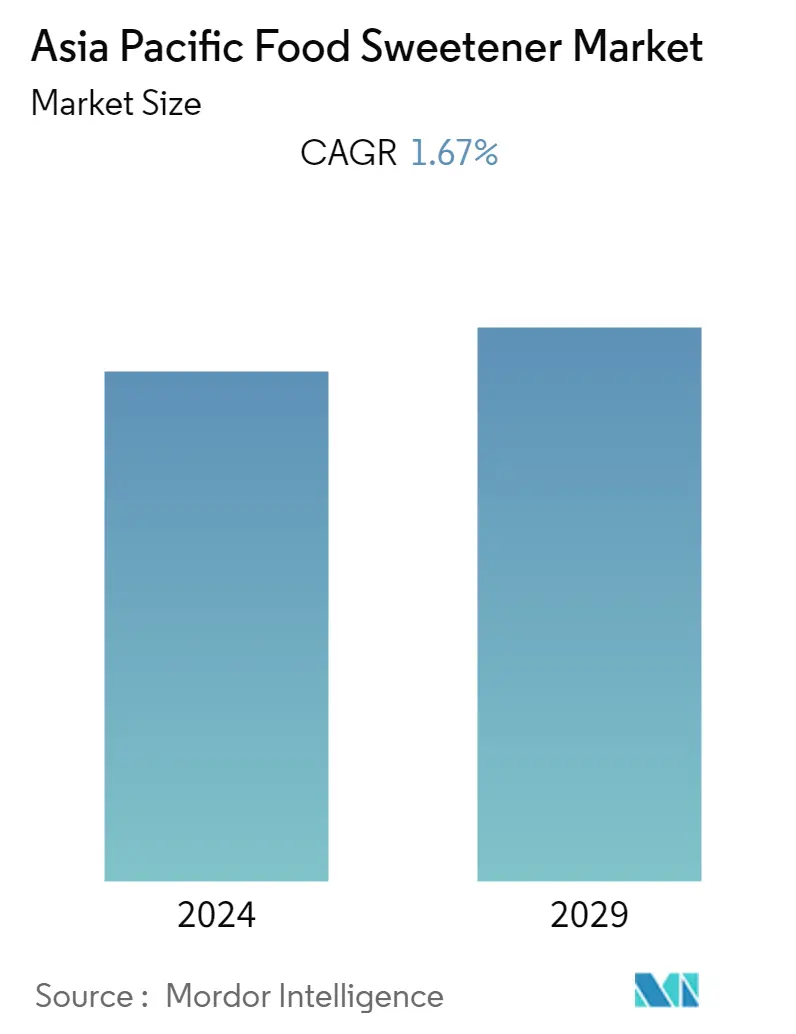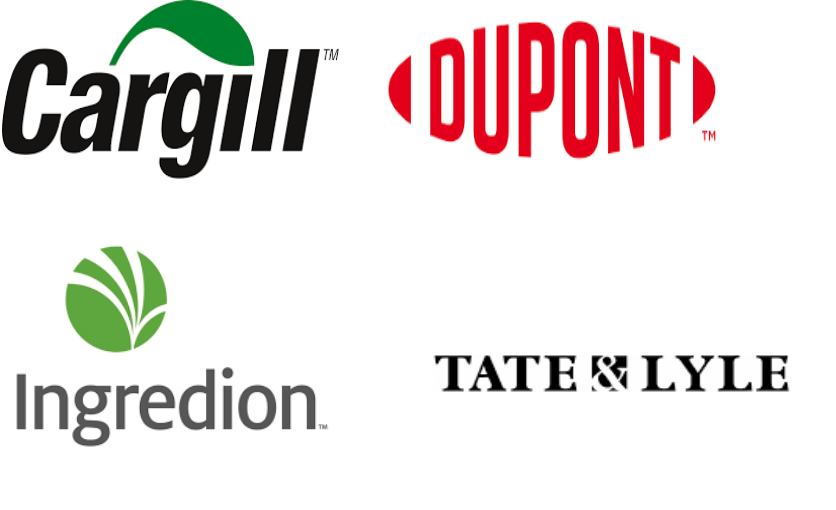Market Size of Asia Pacific Food Sweetener Industry

| Study Period | 2019 - 2029 |
| Base Year For Estimation | 2023 |
| Forecast Data Period | 2024 - 2029 |
| Historical Data Period | 2019 - 2022 |
| CAGR | 1.67 % |
| Market Concentration | Low |
Major Players
*Disclaimer: Major Players sorted in no particular order |
APAC Food Sweetener Market Analysis
The Asia-Pacific Food Sweetener Market is growing at a very slow pace, registering a CAGR of 1.67% during the forecast period (2020-2025).
- China is the largest bulk sweetener consuming country in the Asia-Pacific region, accounting for a major share of the bulk sweeteners market.Moreover, the country is the primary source of sugar substitutes.
- The remarkable growth in the Food and Beverage market is also driving the food sweetener market.There is a rising prevalence of diabetes, obesity, and cardiac diseases, due to the high consumption of sugar-based products. This, in turn, is augmenting the demand for sweeteners.
- With the changing regulatory environment and permission for using sweeteners in dairy products, biscuits, and confectionery, the artificial sweeteners segment is witnessing high growth.
APAC Food Sweetener Industry Segmentation
Asia pacific Food Sweetener Market is segmented by Type into Sucrose, Starch Sweeteners and Sugar Alcohols and High Intensity Sweeteners. By Application into Dairy, bakery, Beverages and Confectionery, Soups, Sauces and Dressings and Others. Regional Analysis of the market is also included.
| By Product Type | ||||||||||
| Sucrose (Common Sugar) | ||||||||||
| ||||||||||
|
| By Application | |
| Dairy | |
| Bakery | |
| Soups, Sauces and Dressings | |
| Confectionery | |
| Beverages | |
| Others |
| Asia Pacific | |
| China | |
| Japan | |
| India | |
| Australia | |
| Rest of Asia-Pacific |
Asia Pacific Food Sweetener Market Size Summary
The Asia-Pacific food sweetener market is experiencing gradual growth, driven by the increasing demand for sugar substitutes amid rising health concerns such as diabetes, obesity, and cardiac diseases. China stands out as the largest consumer of bulk sweeteners in the region, significantly influencing the market dynamics. The burgeoning food and beverage sector further propels the demand for sweeteners, as manufacturers seek to reduce calorie content in their products. This shift is facilitated by a changing regulatory landscape that permits the use of artificial sweeteners in various food categories, including dairy, biscuits, and confectionery. As a result, the artificial sweeteners segment is witnessing notable expansion, with products like Stevia gaining traction for their low-calorie benefits.
In Australia, the food sweetener market is growing at a faster pace, largely due to the high demand for sugar substitutes in diet-soft drinks, where aspartame is a leading choice. Despite the presence of stringent regulations, the market is evolving with a focus on natural sweeteners, driven by consumer preference for clean and natural ingredients. Stevia, in particular, is gaining popularity, with powdered forms holding a significant market share. The market is dominated by key players such as Cargill, Tate & Lyle PLC, and Ingredion, who are capitalizing on rising disposable incomes and increased consumer spending on healthy foods. This trend is contributing to the market's progressive trajectory across the Asia-Pacific region.
Asia Pacific Food Sweetener Market Size - Table of Contents
-
1. MARKET DYNAMICS
-
1.1 Market Drivers
-
1.2 Market Restraints
-
1.3 Porter's Five Forces Analysis
-
1.3.1 Threat of New Entrants
-
1.3.2 Bargaining Power of Buyers/Consumers
-
1.3.3 Bargaining Power of Suppliers
-
1.3.4 Threat of Substitute Products
-
1.3.5 Intensity of Competitive Rivalry
-
-
-
2. MARKET SEGMENTATION
-
2.1 By Product Type
-
2.1.1 Sucrose (Common Sugar)
-
2.1.2 Starch Sweeteners and Sugar Alcohols
-
2.1.2.1 Dextrose
-
2.1.2.2 High Fructose Corn Syrup (HFCS)
-
2.1.2.3 Maltodextrin
-
2.1.2.4 Sorbitol
-
2.1.2.5 Xylitol
-
2.1.2.6 Others
-
-
2.1.3 High Intensity Sweeteners (HIS)
-
2.1.3.1 Sucralose
-
2.1.3.2 Aspartame
-
2.1.3.3 Saccharin
-
2.1.3.4 Cyclamate
-
2.1.3.5 Ace-K
-
2.1.3.6 Neotame
-
2.1.3.7 Stevia
-
2.1.3.8 Others
-
-
-
2.2 By Application
-
2.2.1 Dairy
-
2.2.2 Bakery
-
2.2.3 Soups, Sauces and Dressings
-
2.2.4 Confectionery
-
2.2.5 Beverages
-
2.2.6 Others
-
-
2.3 Asia Pacific
-
2.3.1 China
-
2.3.2 Japan
-
2.3.3 India
-
2.3.4 Australia
-
2.3.5 Rest of Asia-Pacific
-
-
Asia Pacific Food Sweetener Market Size FAQs
What is the current Asia Pacific Food Sweetener Market size?
The Asia Pacific Food Sweetener Market is projected to register a CAGR of 1.67% during the forecast period (2024-2029)
Who are the key players in Asia Pacific Food Sweetener Market?
Tate & Lyle, Ingredion, Dupont, ADM and Cargill are the major companies operating in the Asia Pacific Food Sweetener Market.

